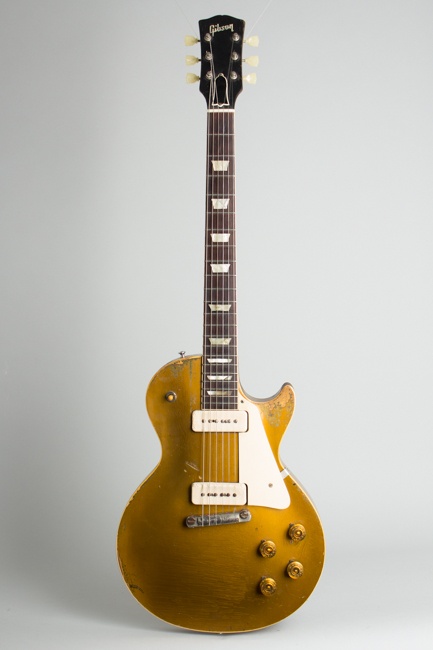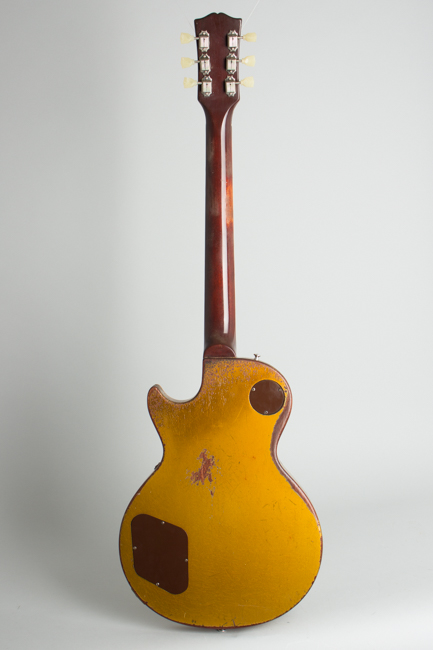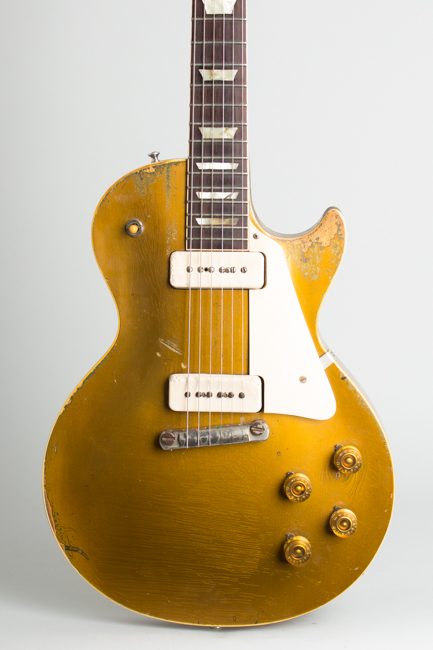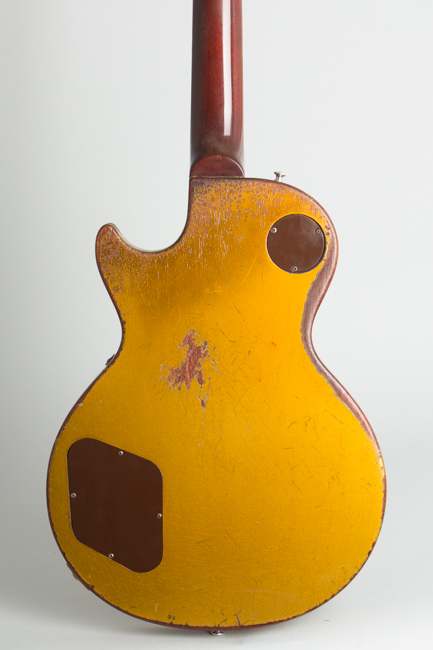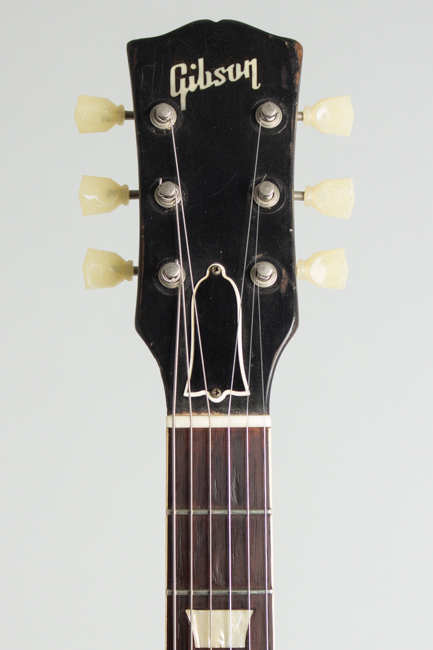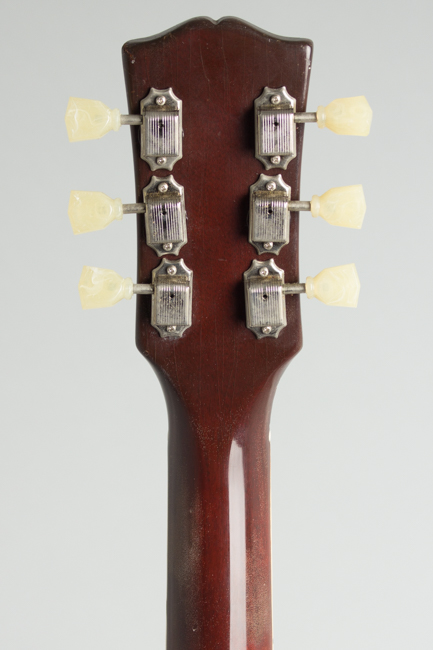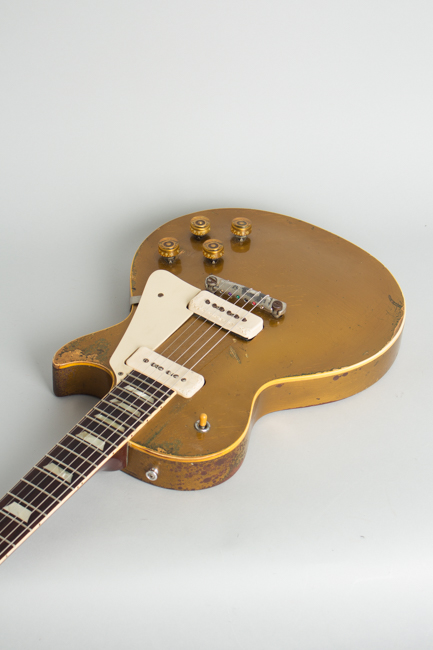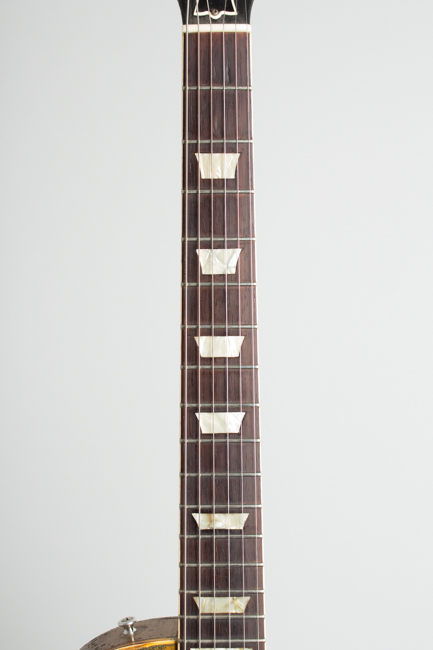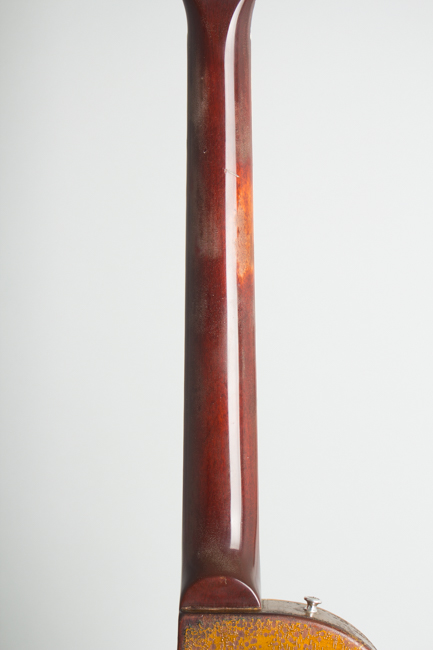Gibson Les Paul Model Solid Body Electric Guitar (1953)
This item has been sold.
Item # 9052
Prices subject to change without notice.
Gibson Les Paul Model Model Solid Body Electric Guitar (1953), made in Kalamazoo, Michigan, gold lacquer finish, mahogany body with maple cap, mahogany neck with rosewood fingerboard, brown hard shell case.
This early Les Paul is a true relic in every way; it appears to have survived not only 55+ years of heavy use but what looks like the effects of a fire along the road! The all-gold body finish remains original and shows not only heavy play wear but burn marks and scars mostly near the neck area; the neck itself has been totally refinished and it appears the original gold lacquer was likely mostly fire damaged long ago. The pearl Gibson logo has survived but the "Les Paul Model" silkscreen is long gone.
This Les Paul is an early example of the "fixed" version of the model from 1953-4. The original trapeze tailpiece designed by Les himself had caused problems for Gibson as the company installed it improperly with the strings running under the bar, which most players found (and still find) difficult to play. This "second generation" version was equipped with the new stop bridge/tailpiece designed by Ted McCarty himself and is a far more playable guitar than the 1952 versions. These early "stoptail" Les Pauls are rightly revered as Blues and rock&roll guitars, and with good reason. This example is the much rarer "all gold" variation that was made inexplicably in much smaller numbers than the standard gold top.
Despite whatever mishap this guitar suffered long ago, the all-important P-90 pickups and wiring rig components appear original including the waxy Grey Tiger capacitors. The visible pot date is to the 19th week of 1953; this is useful as the original inked-on serial number was lost when the neck was refinished. The pickup covers have shrunken and cracked a bit and show some scarring to the tops and trimming at the base. The gold barrel knobs and switch tip are original; the switch ring is later and the "rhythm/treble" plate long gone. The plating on the tailpiece is fairly well-worn as well; the studs show heavy wear. The Kluson Deluxe machines are the correct style but newer reproductions.
Despite a perhaps checkered history, this is a fantastic-playing and sounding guitar, and a great example of why players fell in love with Gibson's original solid-body in the first place. The sound is full and meaty and slides into a stinging overdrive effortlessly with the amp only partially cranked -- it does not get much more "Blues approved" than this. B.B King often told the story of impulsively rescuing his guitar from a burning dance hall in 1949; while this is not that original "Lucille", it may have been part of a similar event! This "genuine relic" 1950s Gibson wears its scars proudly and is ready to keep spinning tales through the next century.
Overall length is 39 in. (99.1 cm.), 13 in. (33 cm.) wide at lower bout, and 1 15/16 in. (4.9 cm.) in depth, measured at side of rim. Scale length is 24 3/4 in. (629 mm.). Width of nut is 1 11/16 in. (43 mm.).
This guitar shows the effects of a hard life, but is still ready to gig. The finish has many scars and wear spots both from play, rough handling, and what appears to be exposure to fire. The neck is completely refinished in a mix of clear and darker lacquer, and the edges of the headstock are well rounded down. It has been very nicely refretted with wire just a bit bigger than the early '50s Gibson spec and plays very well.
Much of the hardware is original; the tuners as noted are repros (the original may well have been ruined long ago) and there are marks from Grover tuners mounted at one time. The stop tailpiece looks original but close examination reveals tiny traces of gold plating so it was likely originally the tailpiece on an old Les Paul Custom. The pickguard and truss rod cover are the correct period pieces but we can't verify for certain they are original to the guitar. The gold color on the body is very strong with a deeper hue than some, and less loss and greening in the armwear area than many. There is one big scar on the face into the wood between the pickups, and a lot of rub-off to the edges.
With play wear all over and the apparent fire damage to the finish but no cracks or breaks, this Les Paul rates as absolutely "ragged but right". The frets have plenty of meat on them and this one will be playing well into this 21st century. It is housed in an odd but very sturdy molded case and looks like it wants to go right back out on the road for more adventures. Very Good Condition.
This early Les Paul is a true relic in every way; it appears to have survived not only 55+ years of heavy use but what looks like the effects of a fire along the road! The all-gold body finish remains original and shows not only heavy play wear but burn marks and scars mostly near the neck area; the neck itself has been totally refinished and it appears the original gold lacquer was likely mostly fire damaged long ago. The pearl Gibson logo has survived but the "Les Paul Model" silkscreen is long gone.
This Les Paul is an early example of the "fixed" version of the model from 1953-4. The original trapeze tailpiece designed by Les himself had caused problems for Gibson as the company installed it improperly with the strings running under the bar, which most players found (and still find) difficult to play. This "second generation" version was equipped with the new stop bridge/tailpiece designed by Ted McCarty himself and is a far more playable guitar than the 1952 versions. These early "stoptail" Les Pauls are rightly revered as Blues and rock&roll guitars, and with good reason. This example is the much rarer "all gold" variation that was made inexplicably in much smaller numbers than the standard gold top.
Despite whatever mishap this guitar suffered long ago, the all-important P-90 pickups and wiring rig components appear original including the waxy Grey Tiger capacitors. The visible pot date is to the 19th week of 1953; this is useful as the original inked-on serial number was lost when the neck was refinished. The pickup covers have shrunken and cracked a bit and show some scarring to the tops and trimming at the base. The gold barrel knobs and switch tip are original; the switch ring is later and the "rhythm/treble" plate long gone. The plating on the tailpiece is fairly well-worn as well; the studs show heavy wear. The Kluson Deluxe machines are the correct style but newer reproductions.
Despite a perhaps checkered history, this is a fantastic-playing and sounding guitar, and a great example of why players fell in love with Gibson's original solid-body in the first place. The sound is full and meaty and slides into a stinging overdrive effortlessly with the amp only partially cranked -- it does not get much more "Blues approved" than this. B.B King often told the story of impulsively rescuing his guitar from a burning dance hall in 1949; while this is not that original "Lucille", it may have been part of a similar event! This "genuine relic" 1950s Gibson wears its scars proudly and is ready to keep spinning tales through the next century.
Overall length is 39 in. (99.1 cm.), 13 in. (33 cm.) wide at lower bout, and 1 15/16 in. (4.9 cm.) in depth, measured at side of rim. Scale length is 24 3/4 in. (629 mm.). Width of nut is 1 11/16 in. (43 mm.).
This guitar shows the effects of a hard life, but is still ready to gig. The finish has many scars and wear spots both from play, rough handling, and what appears to be exposure to fire. The neck is completely refinished in a mix of clear and darker lacquer, and the edges of the headstock are well rounded down. It has been very nicely refretted with wire just a bit bigger than the early '50s Gibson spec and plays very well.
Much of the hardware is original; the tuners as noted are repros (the original may well have been ruined long ago) and there are marks from Grover tuners mounted at one time. The stop tailpiece looks original but close examination reveals tiny traces of gold plating so it was likely originally the tailpiece on an old Les Paul Custom. The pickguard and truss rod cover are the correct period pieces but we can't verify for certain they are original to the guitar. The gold color on the body is very strong with a deeper hue than some, and less loss and greening in the armwear area than many. There is one big scar on the face into the wood between the pickups, and a lot of rub-off to the edges.
With play wear all over and the apparent fire damage to the finish but no cracks or breaks, this Les Paul rates as absolutely "ragged but right". The frets have plenty of meat on them and this one will be playing well into this 21st century. It is housed in an odd but very sturdy molded case and looks like it wants to go right back out on the road for more adventures. Very Good Condition.
